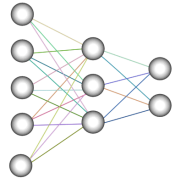DTREG
Software For Predictive Modeling and Forecasting
- Multilayer Perceptron Neural Networks
- Probabilistic Neural Networks
- General Regression Neural Networks
- RBF Neural Networks
- GMDH Polynomial Neural Networks
- Cascade Correlation Neural Networks
- Support Vector Machine (SVM)
- Gene Expression Programming - Symbolic Regression
- Decision Trees
- TreeBoost — Boosted Decision Trees
- Decision Tree Forests
- K-Means Clustering
- Linear Discriminant Analysis (LDA)
- Linear Regression
- Logistic Regression

DTREG also can perform time series analysis and forecasting.
DTREG includes Correlation, Factor Analysis, Principal Components Analysis, and PCA Transformations of variables
The process of extracting useful information from a set of data values is called “data mining”. This data can be used to create models to make predictions. Many techniques have been developed for predictive modeling, and there is an art to selecting and applying the best method for a particular situation. DTREG implements the most powerful predictive modeling methods that have been developed indlucing, TreeBoost and Decision Tree Forests as well as Neural Networks, Support Vector Machine, Gene Expression Programming and Symbolic Regression, K-Means Clustering, Linear Discriminant Analysis, Linear Regression models and Logistic Regression models.
Benchmarks have shown these methods to be highly effective for analyzing and modeling many types of data.
- Ease of use. DTREG is a robust application that is installed easily on any Windows system. DTREG reads Comma Separated Value (CSV) data files that are easily created from almost any data source. Once you create your data file, just feed it into DTREG, and let DTREG do all of the work of creating a decision tree, Support Vector Machine, K-Means clustering, Linear Discriminant Function, Linear Regression or Logistic Regression model. Even complex analyses can be set up in minutes.
- Classification and Regression Trees. DTREG can build Classification Trees where the target variable being predicted is categorical and Regression Trees where the target variable is continuous like income or sales volume.
- Single-tree, TreeBoost, Decision Tree Forests, Support Vector Machine, K-Means clustering, Linear Discriminant Analysis, Linear Regression and Logistic Regression. By simply checking a button, you can direct DTREG to build a classic single-tree model, a TreeBoost model consisting of a series of trees a Decision Tree Forest, a Neural Network, a Support Vector Machine, a Gene Expression Programming, a K-Means Clustering, a Linear Discriminant Analysis function a Linear Regression model. or a Logistic Regression model.
- Automatic tree pruning. DTREG uses V-fold cross-validation to determine the optimal tree size. This procedure avoids the problem of "overfitting" where the generated tree fits the training data well but does not provide accurate predictions of new data.
- Surrogate variables for missing data. DTREG uses a sophisticated technique involving "surrogate variables" to handle cases with missing values. This allows cases with some available values and some missing values to be utilized to the maximum extent when building the model. It also enables DTREG to predict the values of cases that have missing values.
- Visual display of the tree. DTREG can display the generated decision tree on the screen, write it to a .jpg or .png disk file or print it. When printed, DTREG uses a sophisticated technique for paginating trees that cross multiple pages.
- DTREG accepts text data as well as numeric data. If you have categorical variables with data values such as “Male”, “Female”, “Married”, “Protestant”, etc., there is no need to code them as numeric values.
- Data Transformation Language (DTL). DTREG includes a full Data Transformation Language (DTL) programming language for transforming variables, creating new variables and selecting which cases are to be included in the analysis.
- Project files for saving analyses. DTREG saves all of the information about variables, analysis parameters as well as the generated report and tree in a project file. You can later open the project file, alter parameters or rerun it with a different dataset.
- Scoring to predict values. Once a decision tree has been built, you can use DTREG to "score" a new dataset and predict values for the target variable.
- Generated scoring source code. The "Translate" function in DTREG generates C, C++ and SAS® source code to compute predicted values. This source code can be included in application programs to perform high performance scoring of large volumes of data.
- Heavy duty capability. The Enterprise Version of DTREG can handle an unlimited number of data rows -- hundreds of thousands or millions are no problem. DTREG can build classification trees with predictor variables that have hundreds of categories by using an efficient clustering algorithm. Many other decision tree programs limit predictor variables to 16 or less categories.
- DTREG .NET Class Library. The DTREG .NET Class Library can be called from application programs to generate models and compute predicted target values using a model generated by DTREG.
- Introduction to decision trees
- Building and using decision trees
- Using a decision tree to predict values
- Types of variables
- Classification and regression trees
- TreeBoost models
- Decision Tree Forest models
- Multilayer Perceptron Neural Networks
- RBF Neural Networks
- GMDH Polynomial Neural Networks
- Cascade Correlation Neural Networks
- Probabilistic and General Regression Neural Networks
- Support Vector Machine models
- Gene Expression Programming and Symbolic Regression models
- K-Means Clustering models
- Linear Discriminant Analysis models
- Linear Regression models
- Logistic Regression models
- Decision trees compared to regression and neural networks

